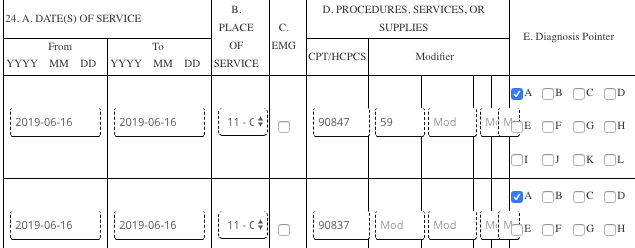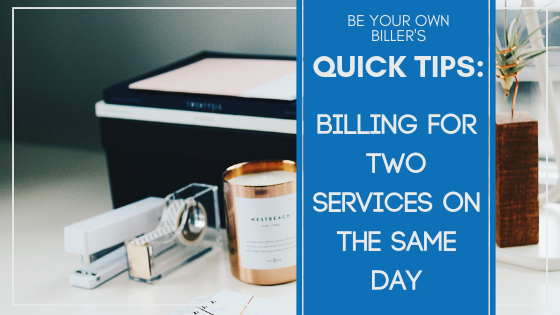It’s been forever since I posted! I’m alive, I promise!
I keep seeing all over my Facebook group (and others!) ‘How do I bill for two services/sessions in the same day?’ Some people are saying it cannot be done, but it actually can!
Here are some examples of what I’m talking about:
- You see a client who is a child for an individual session that lasts 50 minutes (90834) and then have a session with their parent regarding the child’s symptoms (90846) on the same day.
- You see a client for a 55-minute individual session (90837) and then they also attend your group later that evening (90853).
- You meet with a couple for a session (90847) and then meet with the IP of the couple for a 60-minute individual session (90837) on the same day.
There are lots of scenarios where this happens! Although it’s best to try to avoid billing for two services on the same day, sometimes it’s unavoidable with schedules and more convenient for the client if they are scheduled on the same day.
Cue our friend–Modifier 59 (or XE depending on the payer you are billing).
Per CMS, ‘Under certain circumstances, it may be necessary to indicate that a procedure or service was distinct or independent from other non-E/M services performed on the same day. Modifier 59 is used to identify procedures/services, other than E/M services, that are not normally reported together, but are appropriate under the circumstances.’
XE means–Separate Encounter, a Service that is Distinct because it occurred during a Separate Encounter.
Translated: If you are seeing a client for two different types of services aka individual and then group or seeing the child client and then the parent of the client, these are two separate and distinct services that were performed on the same day.
This might be obvious, but it’s also important to note that ‘documentation must support a different session’ meaning you must write two different notes for the two different services you performed.
The key here that this has to be used with two SEPARATE AND DISTINCT SERVICES. It cannot be used for say a two-hour couples session because you are not providing two distinct services.
How do you bill it, you ask?
Here are some screenshots of how I’ve billed it in the past with success (some people put it on both claim lines, I’ve done both):

Modifier 59 in action!
Note not much has changed except for the 59 modifier in the modifier column and the second claim line with the second CPT code etc.
When the claim gets processed, some funky things may happen (based on my experience):
- You may get the EOB back and owe the client money due to them not having to pay two copays (for two services on the same day).
- Due to this–one of the claim lines (usually the lower paying CPT code!) is paid in full.
- One of the claim lines may get denied (usually the higher paying CPT code!)–when this happens, I resubmit a corrected claim.
Some things to consider when billing this modifier:
- I always give the client a heads up before scheduling two services on the same day, that their insurance may not cover both services and they may have to pay out of pocket (contracted rate) for one of the services.
- Frequent use of this code may be a “red flag” resulting in post-payment audits–so I would use it sparingly.
There you have it! Happy Billing!
References:
https://www.cms.gov/Medicare/Coding/NationalCorrectCodInitEd/Downloads/modifier59.pdf
Screenshot taken from my EHR, Simple Practice. It’s great that you can actually see the claim and then edit the claim to input modifier. If you are in the market for a bomb EHR–try Simple Practice out! If you use my affiliate link, you’ll get a $50 credit when you become a subscriber:



